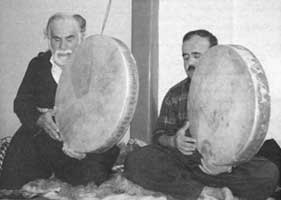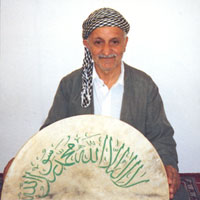Dr. Peyman Nasehpour
Introduction
Frame drums are most ancient type of musical instruments. They have a simple structure with strong spiritual and entertainment effect. Frame drums are usually round made of wood with animal skin and sometimes metal rings or plates incorporated into the drum to provide jingle. They have different sizes; the larger drums are played mainly by men in spiritual rituals and medium size drums are played mainly by women. Frame drums are originated in the ancient Middle East, India and Rome and reached medieval Europe through Islamic culture. Similarity of the names of frame drums in these regions shows the common history of these drums. Daf is one of the most ancient frame drums in Asia and North Africa. In Iran, Sufis use Daf during their Zikr (spiritual chanting) ritual; in recent years Iranian musicians have successfully integrated it into Persian music.
A Brief History of Daf
Its Pahlavi (Persian ancient language) name is dap and daf is arabicized of dap. Some pictures of dap have been found in the paintings to be painted before the birth of Christ. The presence of Persian dap in the stonecutting of Bisotun is really wonderful. (The monuments of Bisotun are situated 25 kilometers from Kermanshah city.) Also there is a kind of square frame drum in the stonecutting of Tagh-e-Bostan (famous monument located 5 kilometers northeast from Kermanshah city). It is said that Nowruz (the first day of the Persian New Year and the national festival of Persia) and other festive occasions have been accompanied by dap in the period of Sassanian (224 A.D. - 651 A.D.). In this period dap has being played in order to accompany khosravani songs.
The presence of the word daf in the poems of many Persian poets shows the importance of this instrument. For example Hafiz, very famous Persian poet and the shining star of the rich Persian literature has applied the word daf in his works ten times. His famous verse that includes the word daf is:

The translation of the verse is:
I, who nights, with the daf and the chang, have dashed down the path of piety,
I, suddenly, bring my head to the path! What a tale this is!
Moors introduced Daf and other Middle Eastern musical instruments to Spain and Spanish adapted and promoted Daf and other musical instruments in medieval Europe. In 15th century daf was only used in Sufi ceremonies, Ottomans reintroduced it to Europe in 17th century.
The art of daf playing in Iran has reached us by the effort of the Iranian Sufis especially in 20th century the late Sayyed Baha-al-Din Shams Ghorayshi (1872-1947), Ostad Haj Khalifeh Karim Safvati (1919-…), Ostad Haj Khalifeh Mirza Agha Ghosi (1928-…), Mohi-al-Din Bolbolani (1929-…), Sayyed Mohammad Shams Ghorayshi (1930-…) and Masha-Allah Bakhtiyari (1940-…).
It is fortunate that daf has been integrated into Persian art music successfully and many young Persian boys and girls have started learning this ancient drum.
Structure of Daf.
Daf has six parts: 1. Frame 2. Skin 3. Pin 4. Hook 5. Ring 6. Leather Band.
| 1. |
Frame is wooden. The diameter of the frame is 48-53 centimeters. The width of the frame is 5-7 centimeters. |
| 2. | Skin is glued on the frame. The most popular is goatskin. |
| 3. |
Pins are applied in behind part of the frame in order to keep the skin on the frame tightly. |
| 4. | Hooks are applied in order to hang the rings in the inner part of frame. |
| 5. | Rings are the jingles of daf. |
| 6. |
Leather band is applied in order to help the player for long duration performances. |
The other instrument that is played in khanghah is the Tas. It is a percussion instrument that is played with wooden or leather sticks. Its body is a copper bowl and the skin is stretched on it. It doesn't have a standard size and its diameter can be from 20 to 30 centimeter. It is played only during the Zikr-e-Ghiyam ceremonies.
Brief Biography of Ostad Haj Khalifeh Karim Safvati
Ostad Haj Khalifeh Karim Safvati, outstanding daf player and master of Sufi vocals, was born in Sanandaj, Kurdistan province of Iran, 1920. He learnt the art of daf playing and Sufi vocals from his father Darvish Abdolmohammad. He was appointed khalife (spritual leader) by sheikh abdolkarim Kasnazani of Kirkuk. His sons Mashallah and Jamal are good daf players and accompany their respected fathers in his performances

Ostad Haj Khalifeh Karim Safvati and his son
Brief Biography of Ostad Mirza Agha Ghosi
Ostad Mirza Agha Ghosi, outstanding daf player and master of Sufi vocals, was born in Sanandaj, Kurdistan province of Iran, 1928. He learnt the art of daf playing and Sufi vocals in during his teenage from his father Haji Ghowsi and later with Darvish Karim. He was appointed khalife (spritual leader) by sheikh abdolkarim Kasnazani of Kirkuk. He is one of the oldest daf players of Iran and he has a very nice vocals. He has performed in many festivals of Iran, France, Colombia, Turkey, Panama, Peru and Ecuador. His sons Abd-al-Rahman and Ali-Reza are good daf players and singers and accompany their respected fathers in his performances.

Ostad Mirza Agha Ghosi
Bijan Kamkar
Bijan Kamkar, was born in Sanandaj, Kurdistan province of Iran, 1949. He started learning the music under the training of his father, the late Hassan Kamkar. He was learnt tombak. After receiving the Diploma Degree of High School, he entered the Fine Arts Faculty of University of Tehran to continue his musical studies. He started playing Daf in 1974 and for the first time as a member of Shayda Ensemble. He introduced Daf into traditional Iranian music at Shiraz Art Festival and Toos Art Festival.
Acknowledgement
The author wishes to thank Ostad Mirza Agha Ghosi and his sons Abd-al-Rahman and Ali-Reza for their help.
References:
Kurdistan Zikr et chants soufis, Radio France, Paris, November 1994.
[B]: Arfan Beomid-e-Hagh, The School of Playing Daf, Ebteda Publication, Tehran, 1998.
[H]: Khajeh Shams-al-Din Mohammad Hafiz Shirazi, Divan-e-Hafiz, by the effort of Ms. Salehe Salehpour, Persian to English Translator: Henry Wilberforce Clarke, Booteh Press, Tehran, 1998.
[N]: Peyman Nasehpour, Personal Research in Khanghah of Ostad Haj Khalifeh Mirza Agha Ghosi (Sanandaj city), 1996.
[S]: Dr. Mahindokht Sadighian and Dr. Abutaleb Mir Abedini, Farhang-e-Vazhe Nama-ye-Hafiz (Concordance et Frequence de la Hafiz), Amir Kabir Publication Corp., Tehran, 1987.
[T]: Emad Tohidy, An Introduction to Daf Playing, Kerman Music Society, Third Publication, 1994